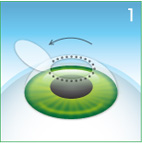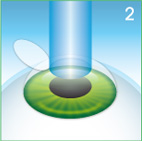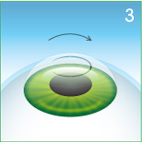 |
 |
 |
 |
 |
 |
 |
 |
 |
|
 |
“LVC has made living an active life easy and
hassle-free. It has been over a year since my
successful surgery and I could not be doing
the things I do today without it.”
Samantha Flather, Attorney |
 |
 |
 |
 |
 |
|
 |
 |
|
|
|
|
 |
A Closer Look:
Correcting Refractive Errors with LVC |
|
| |
The goal of LVC is to correct the shape of the cornea so that the incoming light rays are focused clearly in the eye. The excimer laser can precisely reshape the cornea as each pulse of the laser removes 0.25 microns (0.00004 inches) of corneal tissue. The distribution, pattern and number of pulses is computer controlled and leaves the cornea with a new shape resulting in correcting the refractive errors. Both LASIK and PRK take 5-10 minutes per eye, are performed under topical anesthesia with mild oral sedation, and apart from a brief sensation of pressure on the eye, are generally painless. Our most commonly performed procedure is all-laser custom LASIK (also called Custom LASIK with intraLase™, bladeless LASIK and intra LASIK).
|
Originally all flaps were created with a bladed mechanical device called a microkeratome. More recently the IntraLase has become popular for creating the flap (“bladeless LASIK”). The IntraLase offers benefits in virtually every aspect of LASIK, including safety, accuracy, predictability, diminished side effects and stability of results. LASIK does not disrupt the front surface of the cornea and is therefore generally less painful and has a quicker recovery period. Most patients experience a dramatic overnight improvement. |
|
LASIK (Laser in Situ Keratomileusis)
LASIK involves creating a flap made up of
the superficial layers of the cornea (fig.1), |
Laying the flap aside temporarily and
then using an excimer laser to reshape
the underlying surface (fig. 2). |
The flap is then returned to its original position where the cornea’s natural physiology holds it in place (fig.3). |
|
 |
 |
 |
|
After a thorough evaluation, we will sometimes find that LASIK is not a good option for
certain individuals; very often, PRK will be a suitable alternative.
PRK (Photorefractive Keratectomy)
PRK is similar to LASIK except that no flap is created. The protective surface layer of the cornea (the corneal epithelium) is removed and the excimer laser then reshapes the cornea. The epithelium grows back over 3-4 days, during which there may be some discomfort; vision usually improves once healing is complete. |
Both LASIK and PRK take 5-10 minutes per eye, are performed under topical anesthesia with mild oral sedation, and apart from a brief sensation of pressure on the eye, both are generally painless. |
|
|
|
 |
 |
 |
 |
 |
 |
 |
 |
 |
 |
 |
 |
 |
 |
 |
 |
ClearSight Laser Centers --- >
|
NEWPORT BEACH CENTER: 3501 Jamboree Road, Suite 1100,
Newport Beach, CA 92660 ph: 949.600.4668 |
FULLERTON CENTER: 2575 Yorba Linda Blvd,
Fullerton, CA 92831 ph: 714.257.0560 |
FRESNO CENTER: 1680 E. Herndon Ave. #101,
Fresno, CA 93720 ph: 559.473.4053 |
|
 |
|